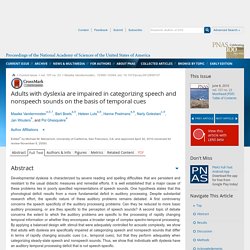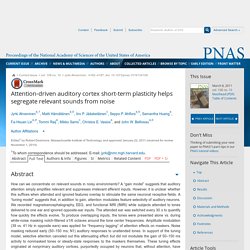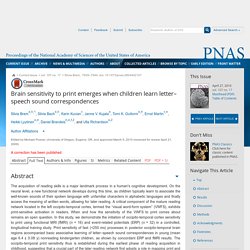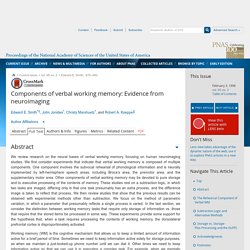

Proceedings of the National Academy of Sciences. Auditory Processing Disorder International Research. Adults with dyslexia are impaired in categorizing speech and nonspeech sounds on the basis of temporal cues. Author Affiliations Edited* by Michael M.

Merzenich, University of California, San Francisco, CA, and approved April 30, 2010 (received for review November 9, 2009) Abstract Developmental dyslexia is characterized by severe reading and spelling difficulties that are persistent and resistant to the usual didactic measures and remedial efforts. It is well established that a major cause of these problems lies in poorly specified representations of speech sounds. Speech contains a number of acoustic cues that are used to discriminate speech sounds belonging to different phonetic categories. Although previous speech perception studies predominantly indicate that individuals with dyslexia are less categorical than normal readers in the way that they perceive phonetic contrasts, especially stop consonants (7–28; but see 6, 29–32 for contra-evidence), these studies are inconclusive as to whether these problems are exclusive to speech. Fig. 1. Table 1. Results Fig. 2. Table 2. Discussion Methods Stimuli.
Assistive listening devices drive neuroplasticity in children with dyslexia. Author Affiliations Edited by Thomas D.

Albright, The Salk Institute for Biological Studies, La Jolla, CA, and approved August 3, 2012 (received for review April 23, 2012) Abstract. Amplitude envelope onsets and developmental dyslexia: A new hypothesis. Author Affiliations Communicated by James L.

McClelland, Carnegie Mellon University, Pittsburgh, PA (received for review January 25, 2002) Attention-driven auditory cortex short-term plasticity helps segregate relevant sounds from noise. Author Affiliations Edited* by Robert Desimone, Massachusetts Institute of Technology, and approved January 22, 2011 (received for review November 1, 2010) Abstract How can we concentrate on relevant sounds in noisy environments?

A “gain model” suggests that auditory attention simply amplifies relevant and suppresses irrelevant afferent inputs. Auditory plasticity and speech motor learning. Author Affiliations Edited by Michael M.

A structural–functional basis for dyslexia in the cortex of Chinese readers. Author Affiliations Communicated by Robert Desimone, Massachusetts Institute of Technology, Cambridge, MA, February 25, 2008 (received for review January 1, 2008) Abstract Developmental dyslexia is a neurobiologically based disorder that affects ≈5–17% of school children and is characterized by a severe impairment in reading skill acquisition.

For readers of alphabetic (e.g., English) languages, recent neuroimaging studies have demonstrated that dyslexia is associated with weak reading-related activity in left temporoparietal and occipitotemporal regions, and this activity difference may reflect reductions in gray matter volume in these areas. Beat synchronization predicts neural speech encoding and reading readiness in preschoolers. Brain sensitivity to print emerges when children learn letter–speech sound correspondences. Author Affiliations Edited by Michael Posner, University of Oregon, Eugene, OR, and approved March 5, 2010 (received for review April 21, 2009) A correction has been published Abstract.

Components of verbal working memory: Evidence from neuroimaging. Abstract We review research on the neural bases of verbal working memory, focusing on human neuroimaging studies.

We first consider experiments that indicate that verbal working memory is composed of multiple components. One component involves the subvocal rehearsal of phonological information and is neurally implemented by left-hemisphere speech areas, including Broca’s area, the premotor area, and the supplementary motor area. Other components of verbal working memory may be devoted to pure storage and to executive processing of the contents of memory. These studies rest on a subtraction logic, in which two tasks are imaged, differing only in that one task presumably has an extra process, and the difference image is taken to reflect that process. Working memory (WM) is the cognitive mechanism that allows us to keep a limited amount of information active for a brief period of time.
Research on human WM has been carried out at both behavioral and biological levels. Figure 1 Figure 2. Dysfunction of the auditory thalamus in developmental dyslexia. Author Affiliations Edited by Michael Merzenich, W.

M. Educational neuroscience: The early years. As developmental cognitive neuroscience explores mechanisms of change at the cognitive and neural systems level, a focus is beginning to emerge on the role of educational experiences in shaping the specific functional circuits that give rise to complex cognitive skills such as reading or math.

Such studies mark the emergence of educational neuroscience. This interdisciplinary field tackles questions that stretch beyond the normal boundaries of what neuroscience or education research alone can address. Evidence for aberrant auditory anatomy in developmental dyslexia. Evolution of working memory. The nature of human working memory (WM) has been extensively investigated, with thousands of articles and books on the topic produced over the last half-century. Some of the main findings of this research will be outlined shortly.
However, we know hardly anything about how WM evolved. For that (if we are to go beyond plausible speculation), we need detailed comparative studies. However, remarkably few such studies have been conducted, as we will see. Nevertheless, the emerging consensus about the nature of human WM allows us to frame a series of questions or alternative hypotheses concerning the possible differences between human and animal WM. How Do I Fit through That Gap? Navigation through Apertures in Adults with and without Developmental Coordination Disorder. Abstract During everyday life we move around busy environments and encounter a range of obstacles, such as a narrow aperture forcing us to rotate our shoulders in order to pass through. In typically developing individuals the decision to rotate the shoulders is body scaled and this movement adaptation is temporally and spatially tailored to the size of the aperture.
This is done effortlessly although it actually involves many complex skills. For individuals with Developmental Coordination Disorder (DCD) moving in a busy environment and negotiating obstacles presents a real challenge which can negatively impact on safety and participation in motor activities in everyday life. However, we have a limited understanding of the nature of the difficulties encountered. Citation: Wilmut K, Du W, Barnett AL (2015) How Do I Fit through That Gap? Human brain evolution: From gene discovery to phenotype discovery. Todd M. Preuss1 Author Affiliations Edited by Francisco J. Intracranial dissection of word reading mechanisms. Laurent Cohena,b,c,d,e,1. Mechanisms and streams for processing of “what” and “where” in auditory cortex. Abstract The functional specialization and hierarchical organization of multiple areas in rhesus monkey auditory cortex were examined with various types of complex sounds. Neurons in the lateral belt areas of the superior temporal gyrus were tuned to the best center frequency and bandwidth of band-passed noise bursts.
They were also selective for the rate and direction of linear frequency modulated sweeps. Many neurons showed a preference for a limited number of species-specific vocalizations (“monkey calls”). These response selectivities can be explained by nonlinear spectral and temporal integration mechanisms. The visual cortex of nonhuman primates is organized into multiple, functionally specialized areas (1, 2). Mother’s voice and heartbeat sounds elicit auditory plasticity in the human brain before full gestation. Musicians have enhanced subcortical auditory and audiovisual processing of speech and music. Neural correlates of the episodic encoding of pictures and words. Neural deficits in children with dyslexia ameliorated by behavioral remediation: Evidence from functional MRI. Author Affiliations Contributed by Michael M. Merzenich. Neuroimaging studies of word reading. Normal hearing is not enough to guarantee robust encoding of suprathreshold features important in everyday communication.
Neurophysiological origin of human brain asymmetry for speech and language. Abstract The physiological basis of human cerebral asymmetry for language remains mysterious. We have used simultaneous physiological and anatomical measurements to investigate the issue. Neural systems predicting long-term outcome in dyslexia. Neural systems supporting linguistic structure, linguistic experience, and symbolic communication in sign language and gesture. Neuronal representations of distance in human auditory cortex. Sound representation in higher language areas during language generation. Subcortical differentiation of stop consonants relates to reading and speech-in-noise perception. The double identity of linguistic doubling. The fractionation of working memory. The neuroimaging of human brain function. Ventral and dorsal pathways for language. Visual cortex entrains to sign language. Visual word processing and experiential origins of functional selectivity in human extrastriate cortex.